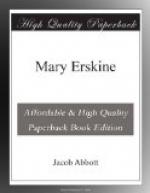Accordingly, a few weeks after Albert died, Mary Erskine went one day in a wagon, taking the baby with her, and Thomas to drive, to the county town, where the Probate court was held.
[Illustration: GOING TO COURT.]
At the Probate court, Mary Erskine made all the arrangements necessary in respect to the estate. She had to go twice, in fact, before all these arrangements were completed. She expected to have a great deal of trouble and embarrassment in doing this business, but she did not find that there was any trouble at all. The Judge of Probate told her exactly what to do. She was required to sign her name once or twice to papers. This she did with great trepidation, and after writing her name, on the first occasion which occurred requiring her signature, she apologized for not being able to write any better. The Judge of Probate said that very few of the papers that he received were signed so well.
Mary Erskine was appointed administratrix, and the Judge gave her a paper which he said was her “Letters of Administration.” What the Judge gave to her seemed to be only one paper, but she thought it probable, as the Judge said “Letters” that there was another inside. When she got home, however, and opened the paper she found that there was only one. She could not read it herself, her studies having yet extended no farther than to the writing of her name. The first time, however, that Mary Bell came to see her, after she received this document, she asked Mary Bell to read it to her. Mary Bell did so, but after she had got through, Mary Erskine said that she could not understand one word of it from beginning to end. Mary Bell said that that was not strange, for she believed that lawyers’ papers were only meant for lawyers to understand.
The appraisers came about this time to make an inventory of the property. They went all over the house and barns, and took a complete account of every thing that they found. They made a list of all the oxen, sheep, cows, horses, and other animals, putting down opposite to each one, their estimate of its value. They did the same with the vehicles, and farming implements, and utensils, and also with all the household furniture, and the provisions and stores. When they had completed the appraisement they added up the amount, and found that the total was a little over four hundred dollars, Mary Erskine was very much surprised to find that there was so much.
The appraisers then told Mary Erskine that half of that property was hers, and the other half belonged to the children; and that as much of their half as was necessary for their support could be used for that purpose, and the rest must be paid over to them when they became of age. They said also that she or some one else must be appointed their guardian, to take care of their part of the property; and that the guardian could either keep the property as it was, or sell it and keep the money as she thought would be most for the interest of the children; and that she had the same power in respect to her own share.




